Pruritus Therapeutics Market Research, 2031
The global pruritus therapeutics market was valued at $7.9 billion in 2021, and is projected to reach $11.2 billion by 2031, growing at a CAGR of 3.6% from 2022 to 2031. Pruritus therapeutics are medications used in treatment of the pruritus disease. The pruritus is the itching caused to skin due to various factors such as dry skin, allergy and other ailments. A more significant underlying cause is typically indicated when pruritus persists for a longer time. A heightened inflammatory response to a various possible irritants, such as dust, environmental pollutants, animals, and certain foods, can cause eczema, also known as atopic dermatitis. Typical products that cause contact dermatitis include watches, soaps, garments, and jewellery produced with potentially irritating substances.
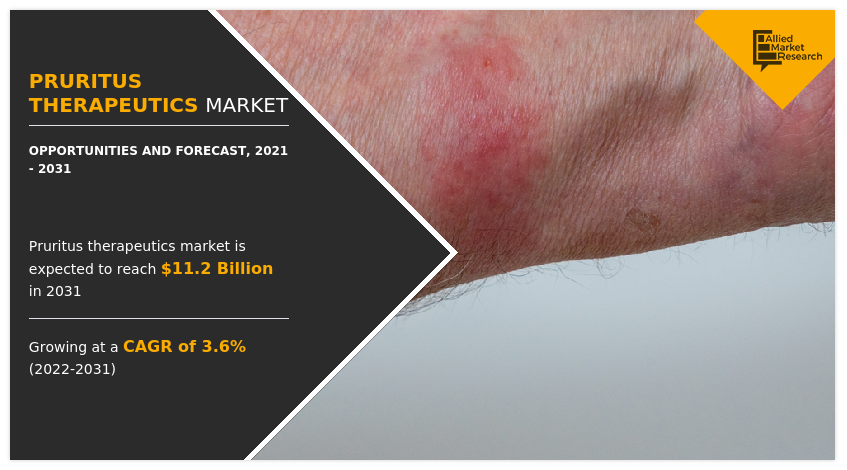
The market of pruritus therapeutics includes the sales of the dermatological products that are used to treat the pruritus. Medical professionals have been using corticosteroids as a topical dosage form for treating pruritus. Corticosteroids have been the first line medication for the treating skin diseases like pruritus, allergic contact dermatitis and AD.
The drivers contributing to the market are the leading market players which are significantly investing in research and development to create innovative pruritus therapies. Investments are also done in order to advance the existing pruritus therapeutics. In addition, launching new medications and building a strong product pipeline is the major focus of the key players. Moreover, because of the low cost, similar effectiveness and convenience of availability, over-the-counter topical medicines are in high demand. As a result, patients are turning more frequently to over-the-counter treatments. These drivers provide a favorable environments for increasing the sales of the pruritus products and also for the pruritus therapeutics market growth. In several conditions the etiology of the disease is not known. However, lack of knowledge regarding cause of the disease creates hindrance to the market but on the other hand, the patent expiry of various pruritus therapeutic products provide a greater pruritus therapeutics market opportunity for players to grow their business.
Impact of COVID-19
Over the past few years, the majority of industries have had adverse effects worldwide due to the pandemic situation. This can be ascribed to the enormous disruptions that various preventive lockdowns and other limitations that were imposed by governing agencies around the world caused in their respective production and supply-chain operations. The same holds true for the global market for pruritus therapeutics. Furthermore, consumer demand has now decreased as people have been more focused on reducing non-essential expenses from their budgets as the general economic condition of majority of people has been adversely impacted by this pandemic.
In COVID-19, urticaria is also typical. Clinical signs, which often take the form of generalized pruritic wheals, do not seem to differ from those of idiopathic urticaria. Urticaria that lasts for less than 11 weeks, has a 97.8% survival rate, and is linked to a relatively benign condition. From 6% to 98.2%. In a systematic review, COVID-19 patients, (12%) had urticarial growths, and in (16%), urticaria started before the other COVID-19 symptoms. This suggests that urticaria can be an indicator to diagnosis in appropriate healthcare situations and can help direct initial testing. Due to this indication, COVID-19 gave an opportunity for increase in sales of the pruritus products keeping the market in a steady level. Thus, COVID 19 is expected to have a moderate impact on the market.
The COVID-19 pandemic continues to alter how diverse businesses develops, although its immediate effects are not all the same. While some industries will see a decline in demand, many others continue to be unaffected and offer bright prospects for expansion.
Pruritus Therapeutics Market Segmentation
The pruritus therapeutics market size is segmented on the basis of drug type, disease type, distribution channels and region. On the basis of drug type, the market is segmented into corticosteroids, antihistamines, local anesthetics, immunosuppressants and others. On the basis of disease type, the market is segmented into atopic dermatitis, allergic contact dermatitis, urticaria and others. On the basis of distribution channels, the market is segmented into hospital pharmacies, drug stores & retail pharmacies and online providers. The drug stores & retail pharmacies is segmented on the basis of route of administration into oral route, parenteral route and topical route.
Region wise, the market is analyzed across North America (the U.S., Canada, and Mexico), Europe (Germany, France, UK, Italy, Spain, and rest of Europe), Asia-Pacific (Japan, China, Australia, India, South Korea, and rest of Asia-Pacific), and LAMEA (Brazil, South Africa, Saudi Arabia, and rest of LAMEA).
Segment Review
By drug type, the market is segmented into corticosteroids, antihistamine, local anesthetics, immunosuppressants and others. The corticosteroid segment generated maximum revenue in 2021 and is estimated to be the fastest growing segment during the forecast peroid, with a high CAGR of 4.4% owing to the high prevalence rate of the disease across the world, leading to high demand for therapeutics for treatment of pruritus. The others segment is anticipated to grow with the high CAGR during the forecast period, after the corticosteroids, which further drives the growth of the pruritus therapeutics market forecast.
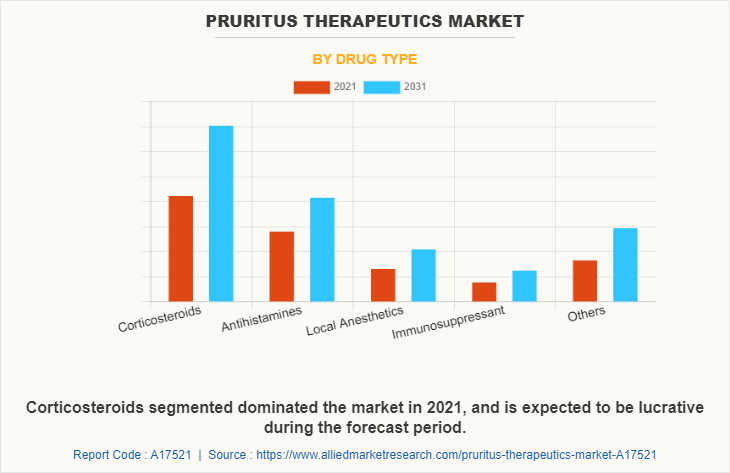
Depending on the disease type, the pruritus therapeutics market size is divided into atopic dermatitis, allergic contact dermatitis, urticaria and others. The atopic dermatitis segment dominated the market in 2021, and is estimated to grow at a CAGR of 3.2% during the forecasted period. The others segment is expected to grow at the fastest CAGR of 4.2% during the forecast period, due to the rising number of patients with unknown causes.
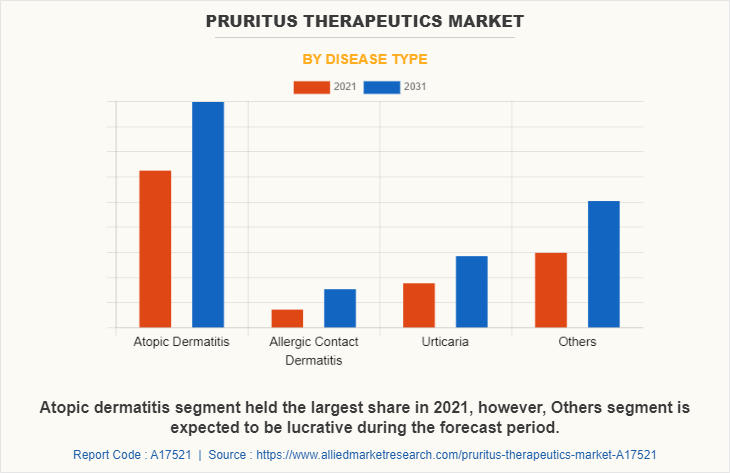
Depending on distribution channels, the pruritus therapeutics industry is divided into hospital pharmacies, drug stores & retail pharmacies and online providers. The drug stores & retail pharmacies segment dominated the pruritus therapeutics market share in 2021 and is estimated to grow with a CAGR of 3.2% during the forecast period. The online providers segment is the fastest growing segment during the forecast period due to the digitalization and ease of purchase and accessibility. The online providers segment is expected to witness highest CAGR of 5.5% during the forecast period.
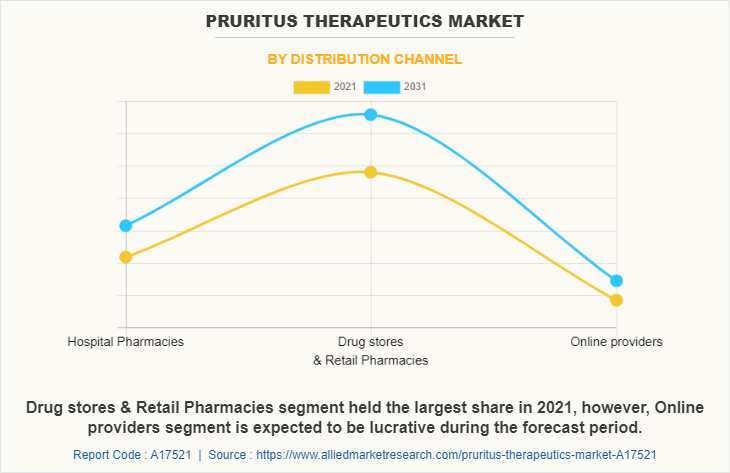
Region wise, North America acquired a major share of the market in the year 2021, owing to presence of key players, rise in government initiatives, well-developed healthcare infrastructure, and increase in prevalence of skin related health issues. The region is expected to grow at a CAGR of 2.7% during the forecast period. However, Asia-Pacific is expected to witness the highest growth rate for the pruritus therapeutics market during the forecast period with a CAGR of 4.7%. Increase in R&D investments, growth in awareness of newer therapies, and rise in consumer preferences toward over the counter products are prime factors that supplement the growth of the Asia-Pacific market. However, insufficient knowledge about pathogenesis and treatment hinders the market growth.
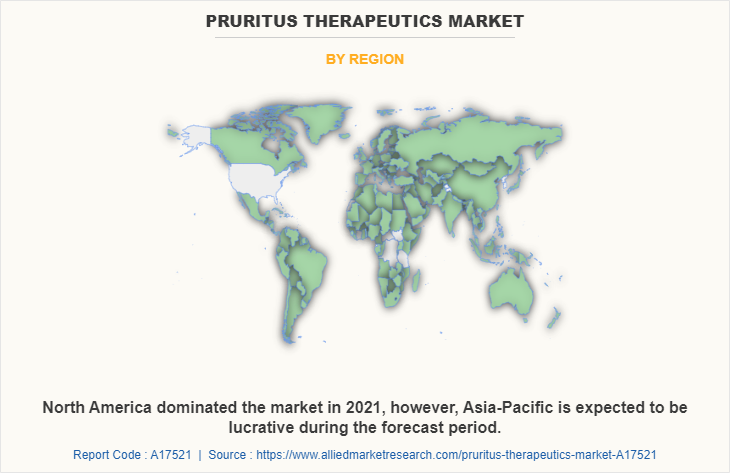
The key players operating in the global pruritus therapeutics market are AbbVie Inc., Amgen Inc., Bausch Health Companies Inc., Cara therapeutics, Inc., Cipla Ltd., Eilly Lilly and Company, Evelo Bioscience, Galderma S.A., LEO Pharma, MC2 Therapeuitics, Novan Inc., Novartis AG, Pfizer Inc., Regeneron Pharmaceuticals, Inc., Sanofi, Trevi therapeutics and Viatris Inc.
Key Benefits For Stakeholders
- This report provides a quantitative analysis of the market segments, current trends, estimations, and dynamics of the pruritus therapeutics market analysis from 2021 to 2031 to identify the prevailing pruritus therapeutics market opportunities.
- The market research is offered along with information related to key drivers, restraints, and opportunities.
- Porter's five forces analysis highlights the potency of buyers and suppliers to enable stakeholders make profit-oriented business decisions and strengthen their supplier-buyer network.
- In-depth analysis of the pruritus therapeutics market segmentation assists to determine the prevailing market opportunities.
- Major countries in each region are mapped according to their revenue contribution to the global market.
- Market player positioning facilitates benchmarking and provides a clear understanding of the present position of the market players.
- The report includes the analysis of the regional as well as global pruritus therapeutics market trends, key players, market segments, application areas, and market growth strategies.
Pruritus Therapeutics Market Report Highlights
| Aspects | Details |
| By Drug type |
|
| By Disease Type |
|
| By Distribution Channel |
|
| By Region |
|
| Key Market Players | Viatris Inc. (Mylan NV), Cipla Ltd., Regeneron Pharmaceuticals, Inc, Sanofi, Galderma S.A., Cara therapeutics, Inc., Novartis AG, Eilly Lilly and company, MC2 therapeuitics, Trevi therapeutics, LEO Pharma, Pfizer Inc., AbbVie Inc., Novan, Inc, Amgen Inc., Evelo Biosciences, Bausch Health Companies Inc. |
Analyst Review
This section provides various opinions of top-level CXOs in the pruritus therapeutics market. According to CXOs, the field of pruritus therapeutics is still nascent and is expected to gain significant attention over the years. The pruritus therapeutics market has acquired the interest of patients, healthcare providers, and practitioners, owing to several benefits offered by these therapies to reduce healthcare cost and manage health of patients efficiently. There have been significant advances in pruritus therapies, which have simplified and made the treatment process more convenient for patients. The market for pruritus medications is expected to experience enormous expansion in the coming years, owing to prevalence of a vast product portfolio and product pipeline. As the market is saturated and is growing at a steady rate in developed nations, Asia-Pacific and LAMEA are expected to offer high growth opportunities to key players in this market.
According to perspectives of CXOs of leading companies in the market, significant advancements in pruritus treatment includes discovering a clear diagnosis and treatment, refrain from scratching, and having confidence in the therapy, which is quite or very important to more than 90% of the patients. Despite the established antipruritic properties of conventional pharmacotherapy, affected individuals frequently do not receive enough relief from these medications. Additional experimental and clinical data have emerged as a result of the expanding pruritic research field, steadily increasing the potential for introducing novel therapeutic strategies. Factors such as increase in research and development investments, shift toward OTC products, and availability of products are key drivers of the market, whereas less pathological evidences regarding disease hinder the market growth.
The global pruritus therapeutics market was valued at $7,849.4 million in 2021, and is projected to reach $11,186.15 million by 2031, registering a CAGR of 3.6% from 2022 to 2031.
Significant investment in research and development to create innovative pruritus therapies is the upcoming trend of pruritus therapeutics market
Corticosteroids is the leading drug type of pruritus therapeutics.
2021 is the base year of pruritus therapeutics market.
2022 to 2031 is the forecast year of pruritus therapeutics market.
North America is the largest regional market for pruritus therapeutics.
AbbVie Inc., Amgen Inc., Bausch Health Companies Inc., Cara therapeutics, Inc., Cipla Ltd., Eilly Lilly and Company, Galderma S.A., Novan Inc., Novartis AG, Pfizer Inc., Sanofi, Trevi therapeutics and Viatris Inc., are the top companies to hold the market share in pruritus therapeutics market.
Loading Table Of Content...



